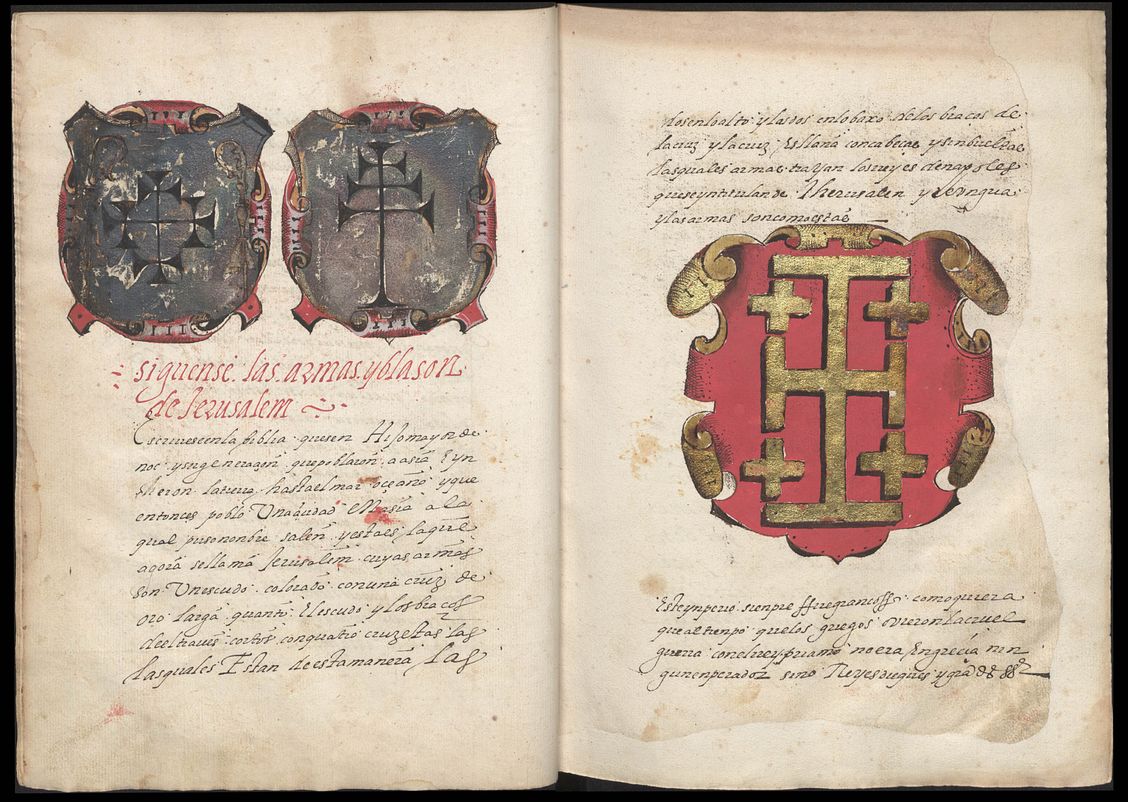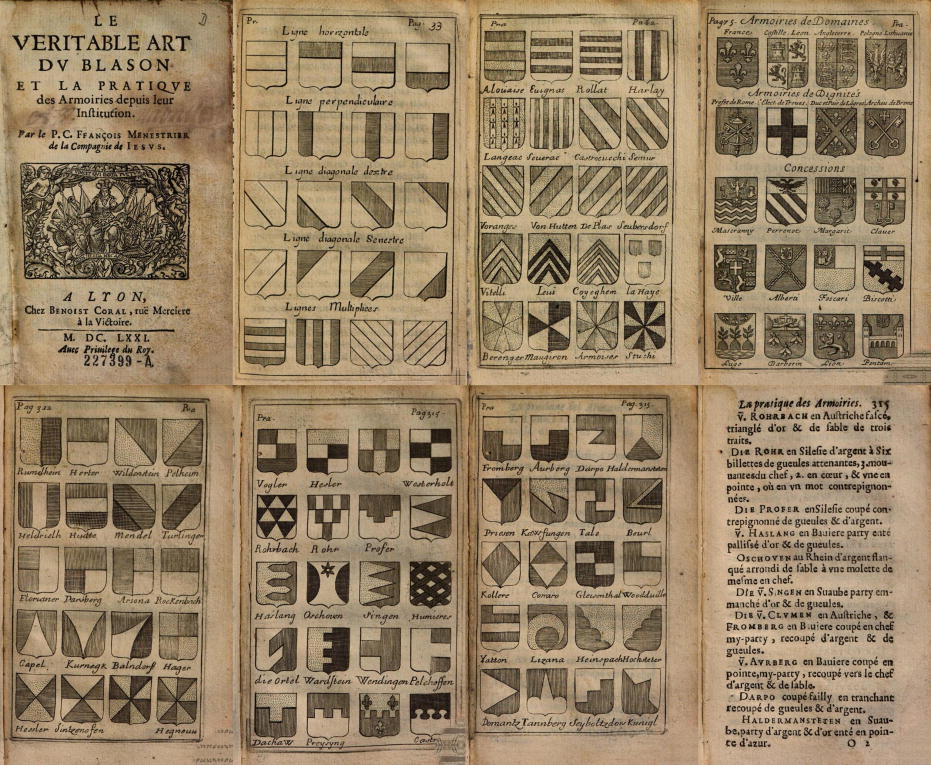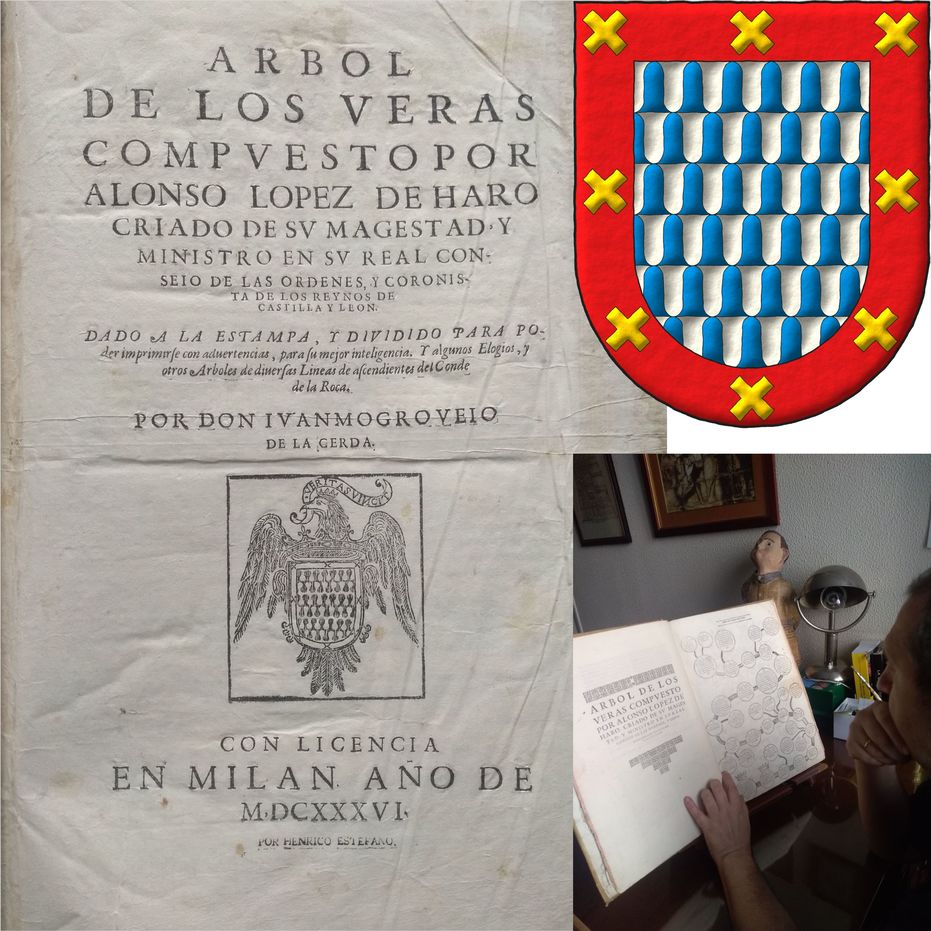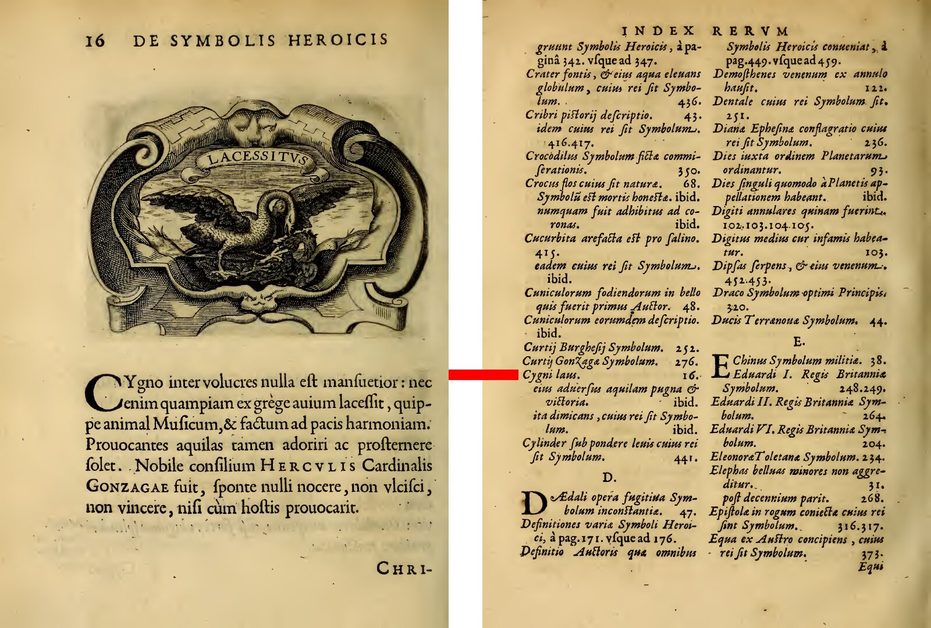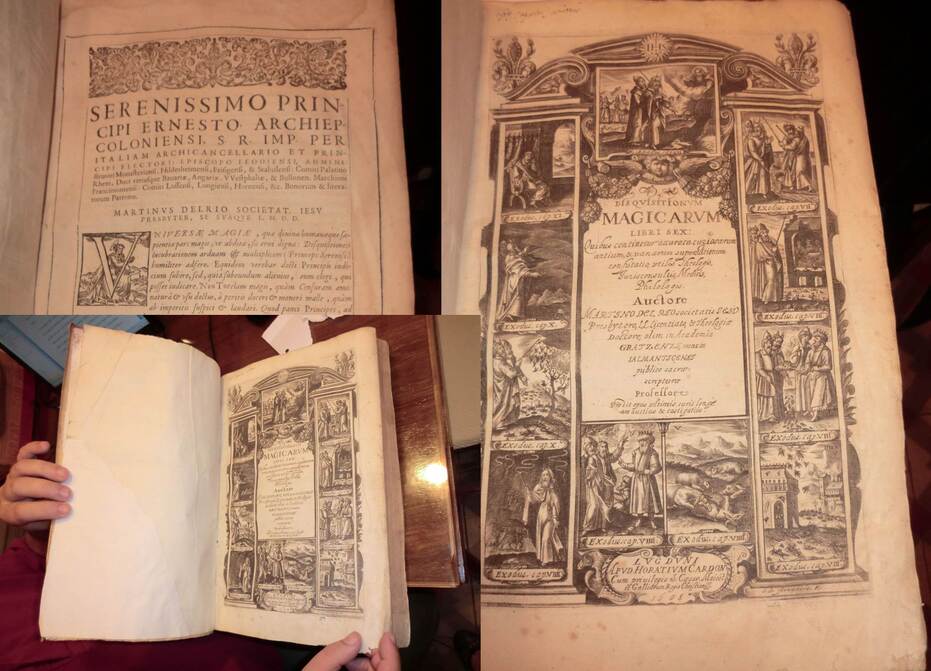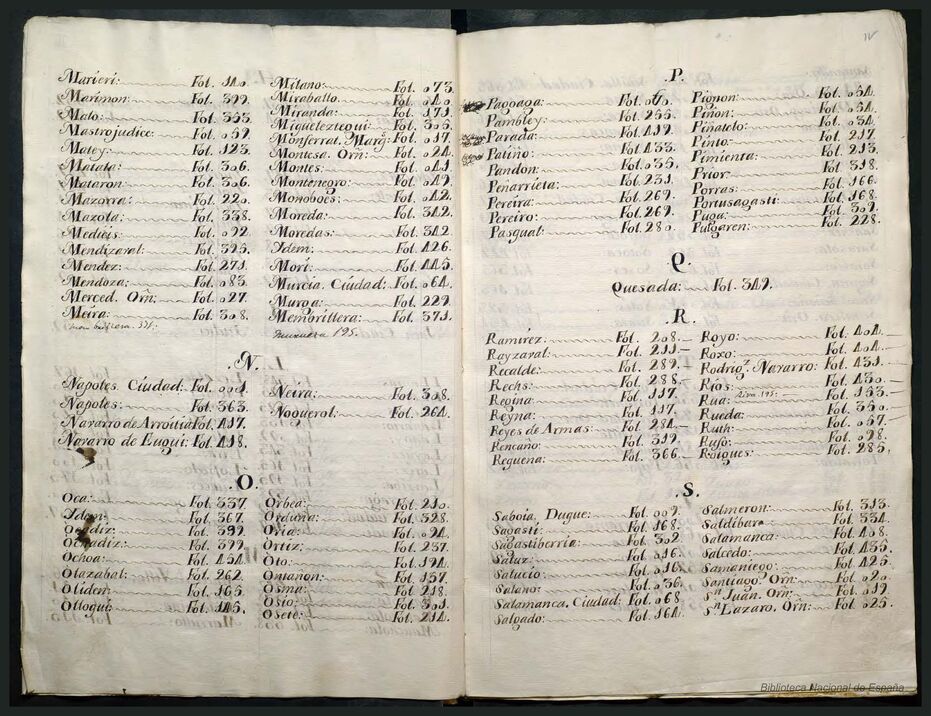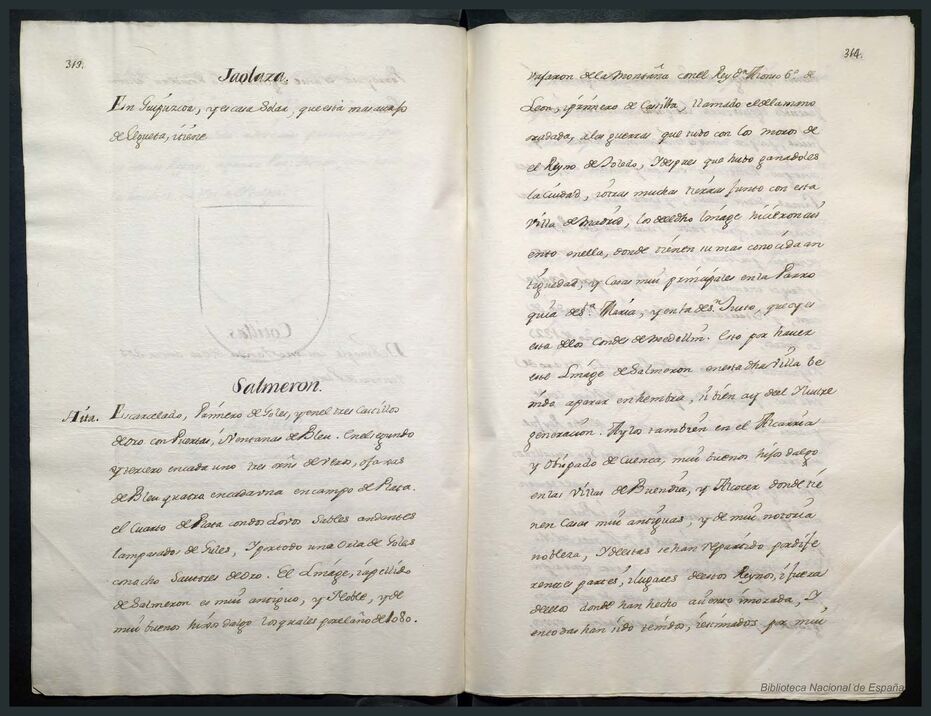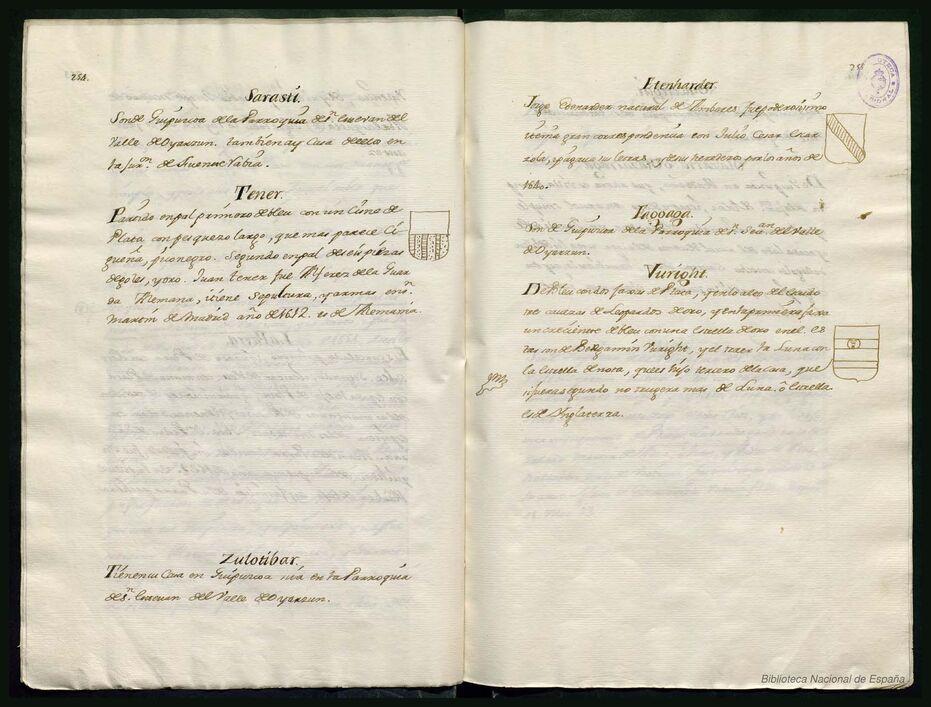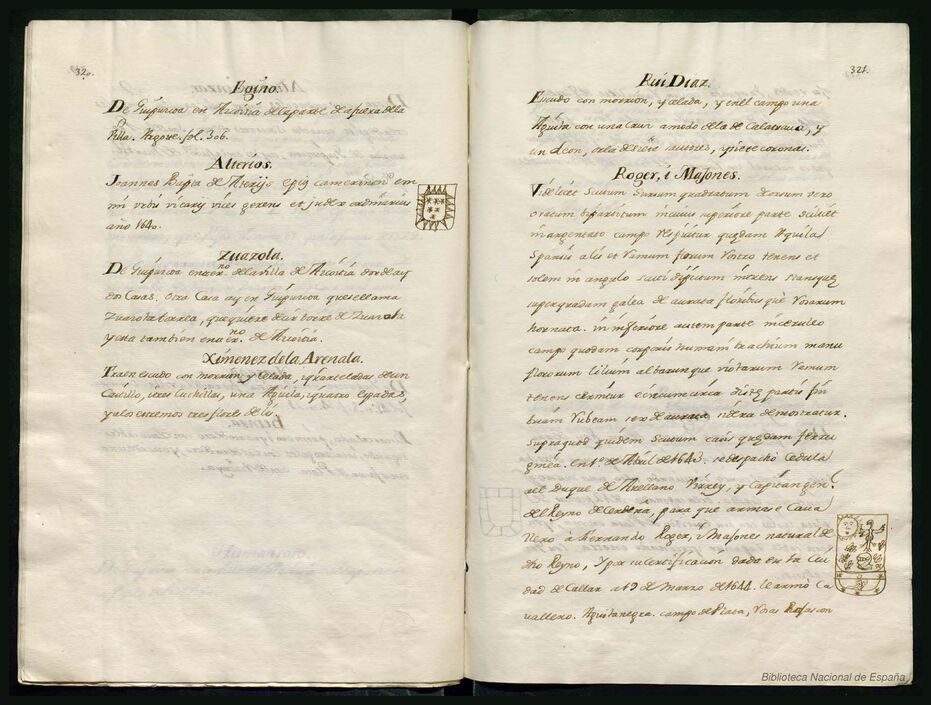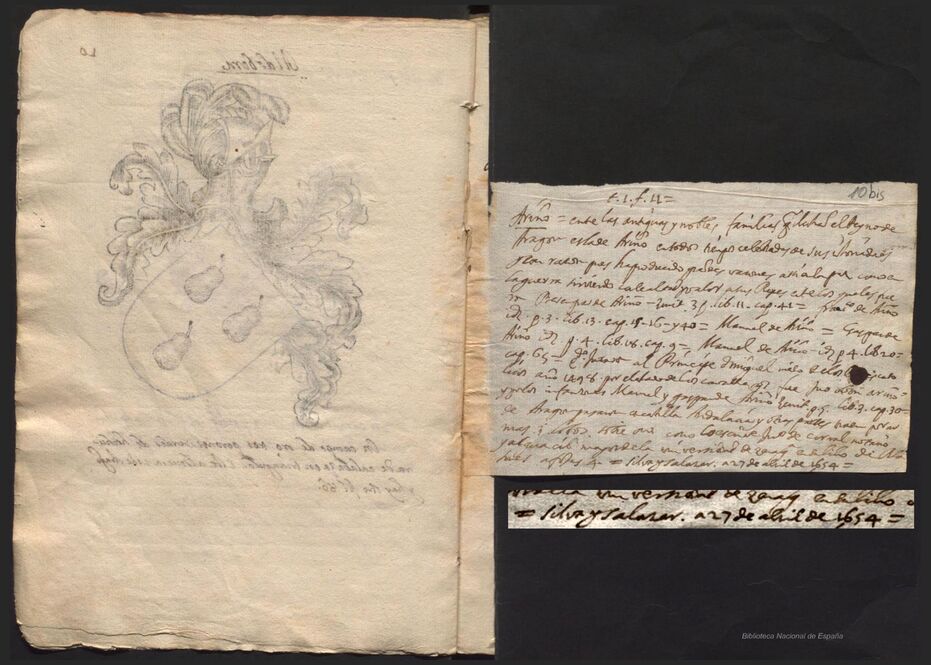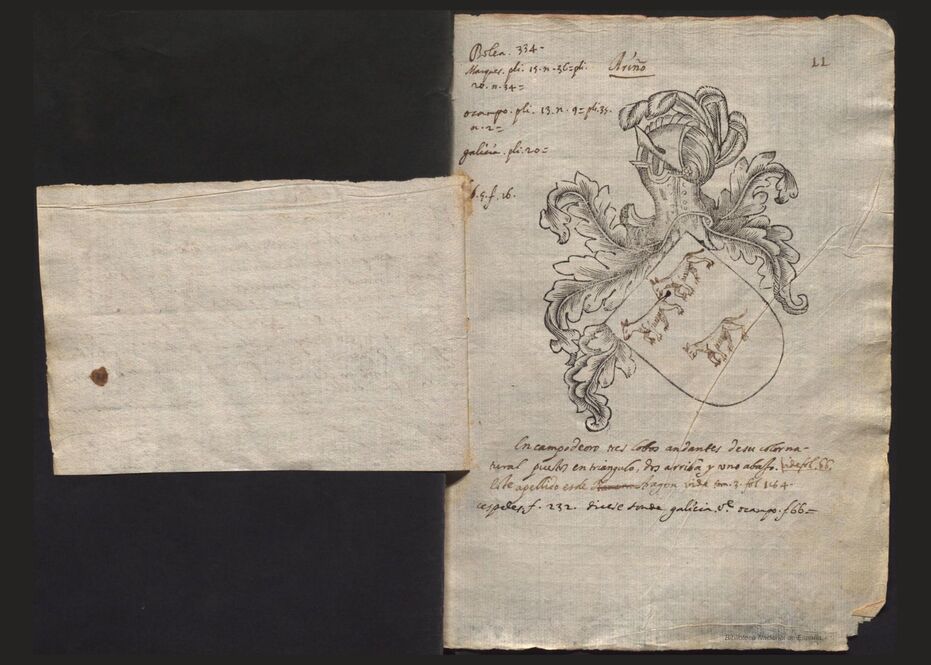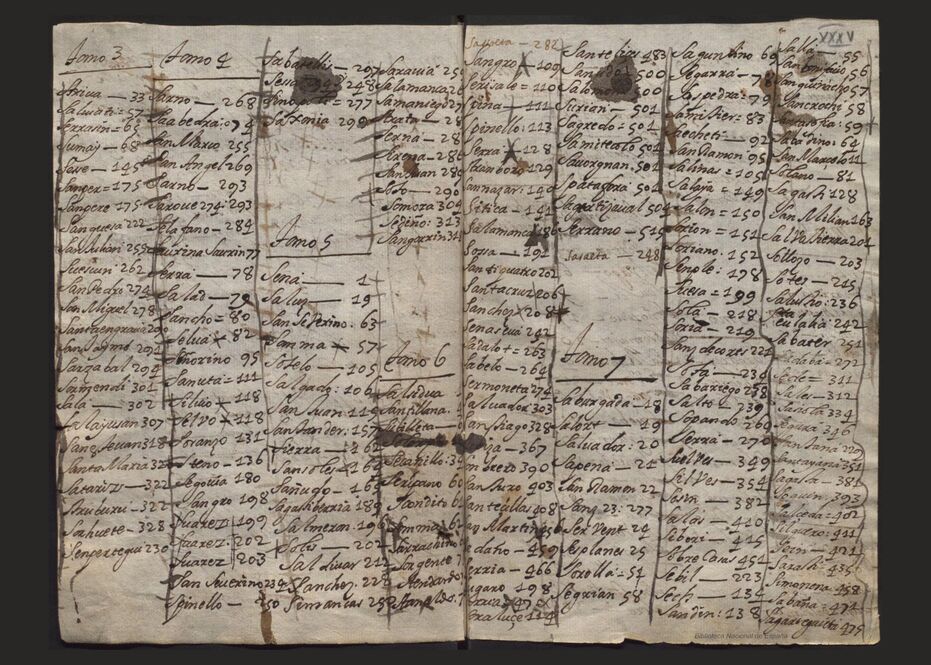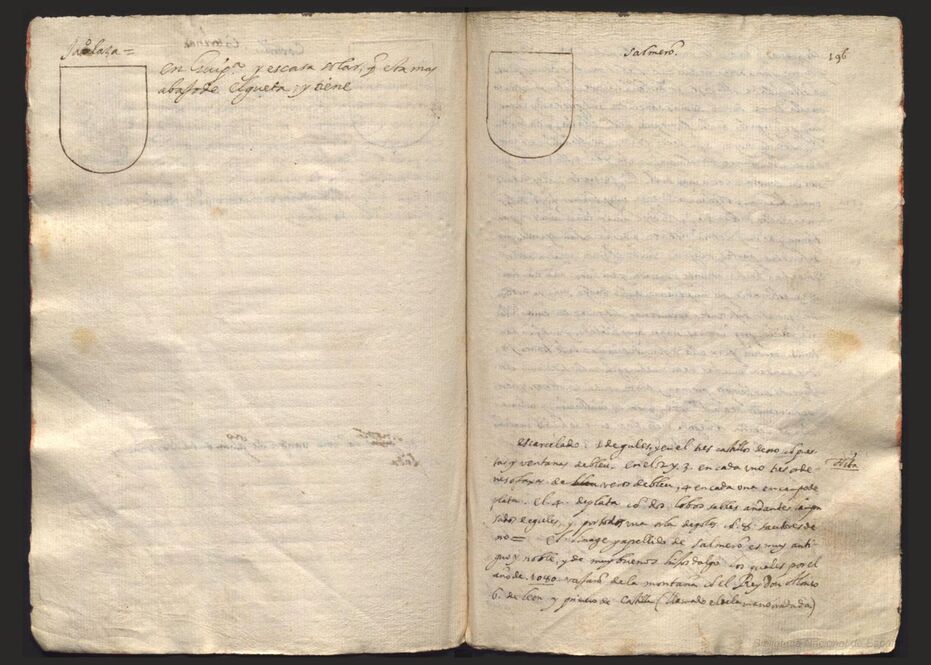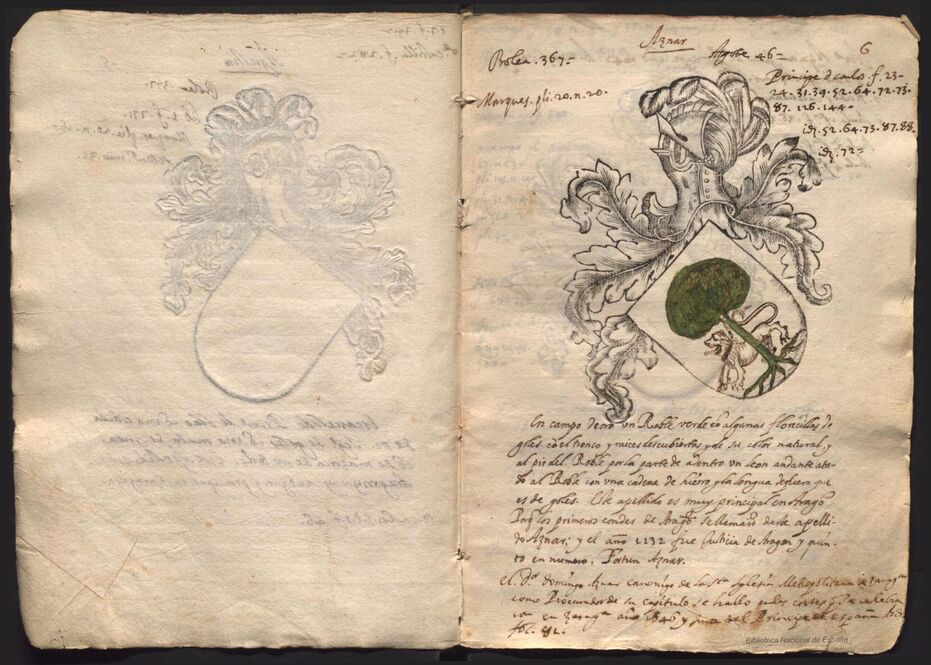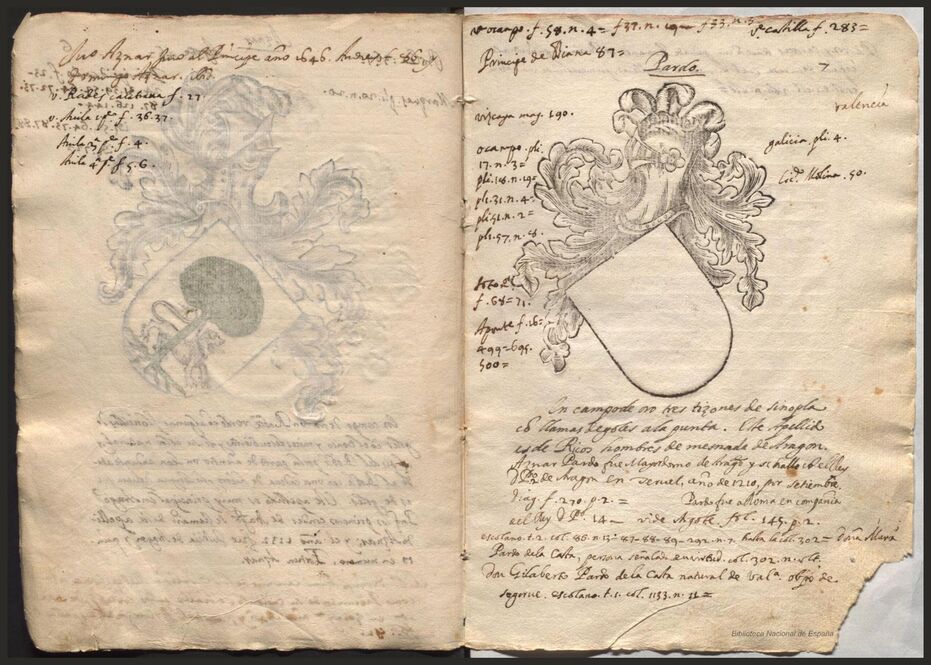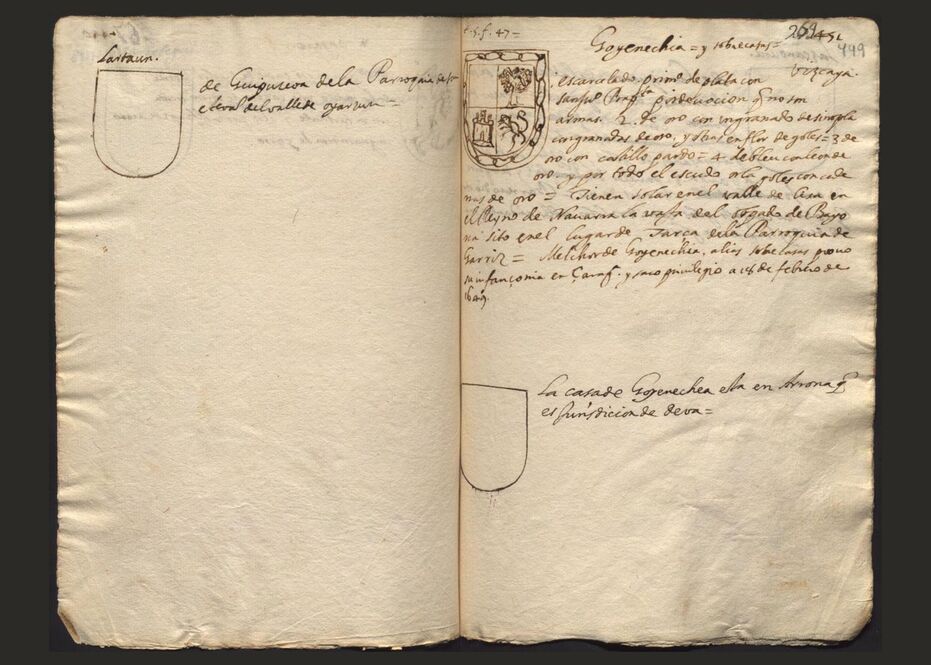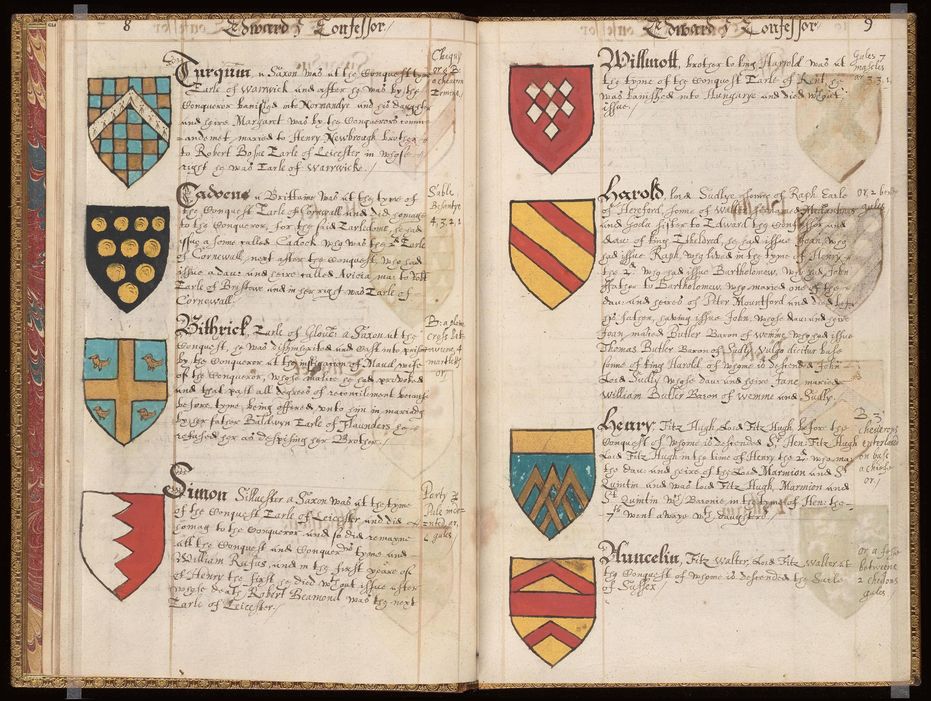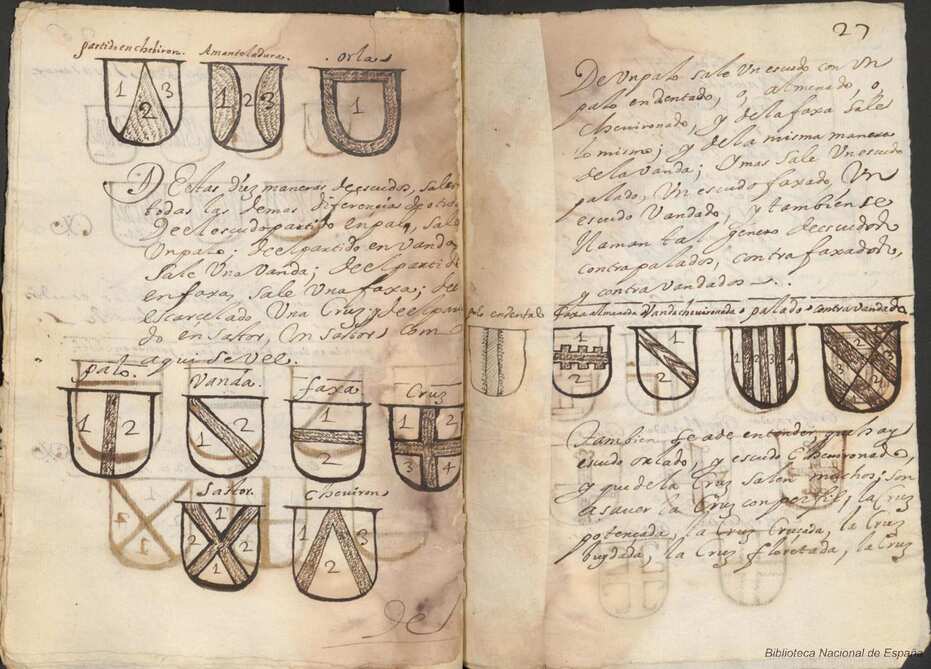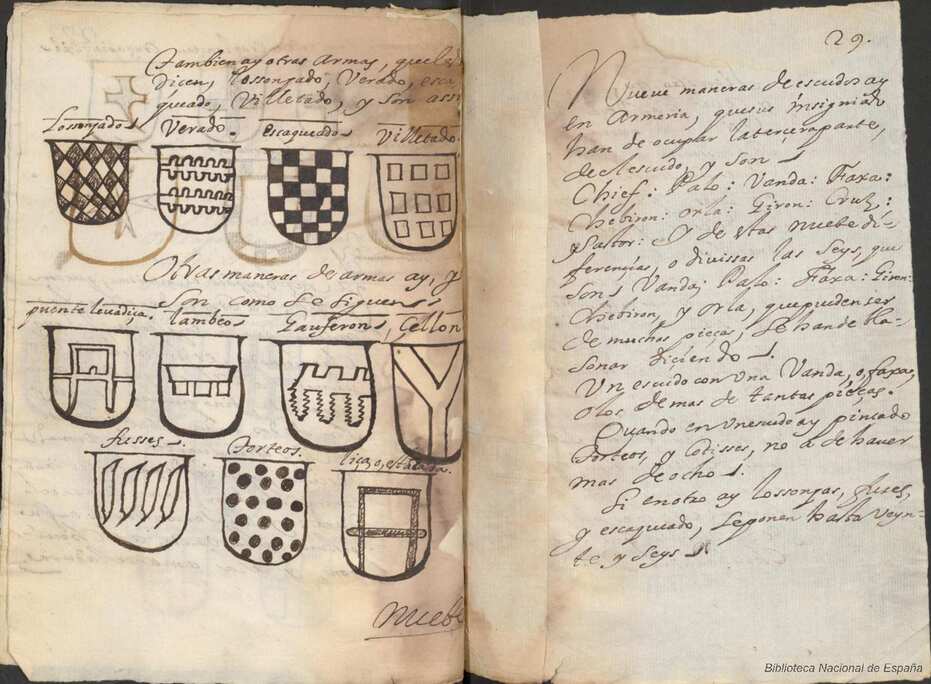Century XVII


![Ver [Cervantes Saavedra, M. de; 1605] en referencias bibliográficas. Libro abierto, hojas de plata, filo de oro, guardas de gules, tapas de sable.](../css/Libro.Bibliografia.png)
Cervantes Saavedra, M. de; 1605
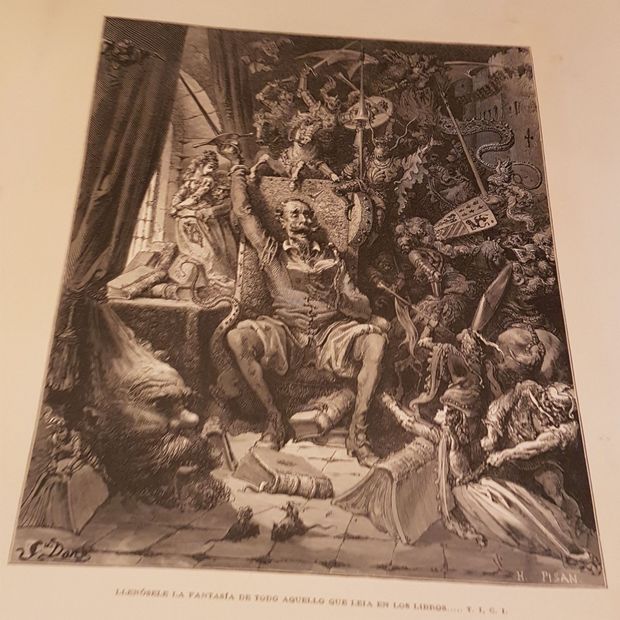
Miguel de Cervantes Saavedra, «El Ingenioso Hidalgo Don Quijote de la Mancha», edition with illustrations by Gustavo Doré, engravings by H. Pisan, in 2 volumes, printed by Imprenta y Librería Religiosa y Científica del Heredero de Don Pablo Riera, Robador Street, 24 and 26, Barcelona, 1875.
Original publication date
The original edition of «El Ingenioso Hidalgo Don Quijote de la Mancha» was published in 1605, with the second part released in 1615.
Illustrated edition details
This 1875 edition is notable for its elaborate illustrations by Gustavo Doré, a renowned French artist, and the detailed engravings by H. Pisan. The illustrations add a rich visual element to Cervantes' classic text, making this edition a significant artistic interpretation of the original work.
First Part, Chapter XVIII, excerpt
«—That knight you see over there with the yellow arms», Or,
«who bears on his shield a crowned lion,
bowed at the feet of a maiden,
is the valiant Laurcalco,
lord of the Silver Bridge;
the other with the golden flowered arms,
who bears on his shield three silver crowns on a blue field,
is the feared Micocolembo, grand duke of Quirocia;
the other with giant limbs,
who stands to his right hand,
is the never fearful Brandabarbarán de Boliche,
lord of the three Arabias,
who comes armed with that serpent's hide and
bears on his shield a door, which, according to legend,
is one of the doors of the temple that Samson destroyed when
he avenged himself on his enemies with his death.
But turn your eyes to the other side and
you will see before and in front
of the other army the always victorious and never defeated
Timonel of Carcajona, prince of New Biscay,
who comes armed with quartered arms,
blue, green, white, and yellow, and bears on his shield
a golden cat on a tawny field,
with an inscription that says «Miau»,
which is the beginning of his lady's name, who,
as they say, is the incomparable Miulina,
daughter of the duke Alfeñiquén of Algarve;
the other who presses down the back of that powerful steed,
who bears arms as white as snow and a shield white and
without any charges, is a novice knight, of French nation,
named Pierres Papín, lord of the baronies of Utrique;
the other who strikes the flanks with the iron-shod heels
of that painted and swift zebra and bears
the blue vair arms,
is the powerful duke of Nerbia, Espartafilardo del Bosque,
who bears as a charge on his shield an asparagus plant,
with an inscription in Castilian that says: «Tracks my fate».
And in this way, he went on naming many knights
from one and the other squadron that he imagined,
and to each of them, he gave
arms, colors, charges, and mottos on the spot,
driven by the imagination of his never-before-seen madness, and,
without stopping, he continued saying...».
Bibliographical reference of century XVII.
Classification: Castilian language and In black and white.
The author is Cervantes Saavedra, Miguel de.
Bibliographic reference mentioned in the following articles:


![Ver [Galdiano L.; Century XVII] en referencias bibliográficas. Libro abierto, hojas de plata, filo de oro, guardas de gules, tapas de sable.](../css/Libro.Bibliografia.png)
Galdiano L.; Century XVII
Anonymous, «Arms and Lineages of Spain», Lázaro Galdiano Foundation, call number 405, manuscript, illustrated, 330 pages, 29 x 22 centimeters, century XVII.
Content and notes
This manuscript contains heraldic descriptions and illustrations of coats of arms, with a coat of arms at the end of each lineage. The coats of arms are painted at the end, and the title of the next lineage is written so close, sometimes physically attached, that one might believe that the title under the coat of arms belongs to the lineage of the coat of arms, when it is actually the coat of arms of the previous lineage. The initial index occupies 20 pages, then the folios are numbered r, recto, up to 194, folio 195 is numbered, its title is «of the Medranos» and it contains an unusual coat of arms, by another hand and without tinctures, folio 196 is numbered and blank, and the final 14 folios are written in another style, and they are a small compendium of heraldic concepts. I understand that the Medrano family might have owned this manuscript for a time and added their lineage at the end of this armorial.
Physical condition and binding
Some leaves have been restored and reinforced at the margins, and the manuscript is in good condition. There is an annotation in manuscript on the verso of the first guard leaf: «8, 1500, F».
A dry stamp is present on the second guard leaf: «Obrador De Encuadernaciones De Antonio Menard. 15 Cervantes 15 Madrid». The manuscript is bound in vellum with a gilded top edge.
Manuscript index
- Alphabetical table of lineages.
-
Armorial of kings:
- Of the arms of Prester John.
- Follow the arms and blazon of Jerusalem.
- Of the branches of the Kingdom of Cyprus and its King.
- Arms of the German Empire.
- Of the King of Hungary.
- The arms of Frisia and why it lost the name of Kingdom.
- Bohemia.
- Arms of the King of Poland and León.
- Of the kingdom of Sweden and Gothia.
- Of the kingdom of Norway.
- Of the King of Gelandia.
- Of the King of Scotland.
- Arms of England.
- Of the King of Hibernia.
- Arms of Rome.
- Arms of the King of Naples.
- Of the Duke of Milan.
- Of the King of Sicily.
- Of the King of France.
- Those who populated Spain are written.
- Of the Kings of Navarra.
- Of the King of Aragón.
- Of the King of Portugal.
- How the kings of Castilla began.
-
Armorial of lineages:
- Of the Manuels.
- Of the De la Cerda.
- Of the Enríquez.
- Of the Duke of Va Hermosa Don Alonso de Aragón.
- Of the Castillas.
- Of the Guzmanes.
- Of the Flores.
- Of the Ponces de León.
- Of the Carrillos.
- Of the Manriques.
- Of the De Albornoz.
- Of the Riveras.
- Of the Portugals.
- Of the Haros.
- Of the Lara lineage.
- Of the Guevaras.
- Of the Mendozas.
- From where the Hurtados come.
- Of the foundation and surname of Ayala.
- Of the Velascos.
- Of the De Castros.
- Of the Herreras.
- Of the De la Vegas.
- Of the De Tovars.
- Of the Sarmientos.
- Of the Estunigas.
- Of the Añayas.
- Of the Cerezos.
- Of the Heredias.
- Of the Aguilars.
- Of the Pachecos.
- Of the Osorios lineage.
- Another difference of arms.
- Pimentels.
- Of the Avellanedas.
- Of the Bracamontes.
- Of the Cueva.
- Of the Toledos.
- Another difference of arms of Toledo from the Garcías.
- Of the Barrosos.
- Of the Silvas.
- Of the Palomeques.
- Of the Gaitanes.
- Of the Gudiels.
- Of the Sandovals.
- Of the Niños.
- Of the Cervatos.
- Of the Fonsecas.
- Of the Coroneles.
- Of the Avalos.
- Of the Lunas.
- Of the Torquemadas.
- Of the Carvajales.
- Of the Rivadeneiras.
- Of the Padillas.
- Of the Valderrábanos.
- Of the Aguayos.
- Of the Zapatas.
- Of the Mirandas.
- Of the De Acuñas.
- Of the Arellanos.
- Of the Castañedas.
- Of the Quiñones.
- Of the Cornados.
- Of the Cervantes.
- Of the Loaysas.
- Of the Cisneros.
- Of the Dazas.
- Of the Córdobas.
- Of the Matas.
- Of the Aceves.
- Of the Cuellos.
- Of the Villarrueles.
- Of the De Biveros.
- Of the De Rojas.
- Of the De Orozcos.
- Those called from Bizcaya.
- Of the Sorvas.
- Of the Maldonados.
- Of the Fajardos.
- Of the Contreras.
- Of the Moscosos.
- Of the Mejías.
- Of the Sosas.
- Of the Figueroas.
- Of the Barahonas.
- Of the Montoyas.
- Of the Alarcóns.
- Of the La Torre.
- Of the Ludos.
- Of the Moyas.
- Of the Ángulos.
- Of the Calatayuds.
- Of the Gaonas.
- Of the Mendaños.
- Of the Beneros.
- Of the Londoños.
- Of the Quevedos.
- Of the Ulloas.
- Of the Quirogas.
- Of the Liras.
- Of the Meneses.
- Of the Girones.
- Of the constable Miguel Lucas.
- Of the Prados.
- Of the Salazars.
- Of the Solórzanos.
- Of the Cárdenas.
- Of the Biedmas.
- Of the Obregóns.
- Of the Bustos.
- Of the Almansas.
- Of the Puerto Carreros.
- Of the Sartes.
- Of the Carates.
- Of the Aljofríns.
- Of the Barrientos.
- Of the Reinosos.
- Of the Locanas.
- Of the Chacones.
- Of the Pantojas.
- Of the Carranzas.
- Of the Pereas.
- Of the Vanegas.
- Of the Lujanes.
- Of the Calderones.
- Of the La Cadena.
- Of the Delgadillos.
- Of the Clavijos.
- Of the Grajedas.
- Of the Ávila.
- Of the Lisones.
- Of the De Mesas.
- Of the Las Ruelas.
- Of the Rapados.
- Of the Villandrandos.
- Of the Luzones.
- Of the Torres.
- Of the De Soliez.
- Of the Herrezuelos.
- Of the Pavía.
- Of the Berrios.
- Of the Baruas.
- Of the Benavides.
- Two differences of arms.
- Of the Narváez.
- Of the Robles.
- Of the De Ñero.
- Of the Mojicas.
- Of the Bacanes.
- Of the Bastoncillos.
- Of the Bocanegras.
- Of the Castillos.
- Of the De Cañizares.
- Of the Cerezuela.
- Of the Dorantes.
- Of the De Estrada.
- Of the Escobares.
- Of the Salcedos.
- Of the De Inestrosa.
- Of the De Isla.
- Of the Illanes.
- Of the Jaravas.
- Of the Oñez.
- Of the Cuadrados.
- Of the Pardos.
- Of the Penalosas.
- Of the Porras.
- Of the Muñizes.
- Of the Ruecos.
- Of the Sotos.
- Of the Romos.
- Of the Salcedos.
- Of the Tenorios.
- Of the Valdeses.
- Of the Vallejos.
- Of the Villagómez.
- Of the Bargas.
- Of the Verdejos.
- Of the Marinos.
- Of the Morales.
-
Added lineage and coat of arms:
- Of the Medranos.
-
Compendium of heraldic concepts:
- First preamble.
- The rule of heraldry follows.
- Second preamble.
- Third preamble.
- Final fourth preamble.
- The meaning of gold.
- The meaning of silver.
- The meaning of blue.
- The meaning of gules, which is red.
- Sable, which is black.
- The meaning of vert, which is green.
- The meaning of purpure, which is purple.
Bibliographical reference of century XVII.
Classification: Manuscript, Armorial roll, Castilian language and In color.
The author is unknown.
Bibliographical reference mentioned in the following article:
Internal resources: GaldianoLXVII.ArmasLinajesEspaña.pdf PDF format.


![Ver [King, D.; 1656] en referencias bibliográficas. Libro abierto, hojas de plata, filo de oro, guardas de gules, tapas de sable.](../css/Libro.Bibliografia.png)
King, D.; 1656
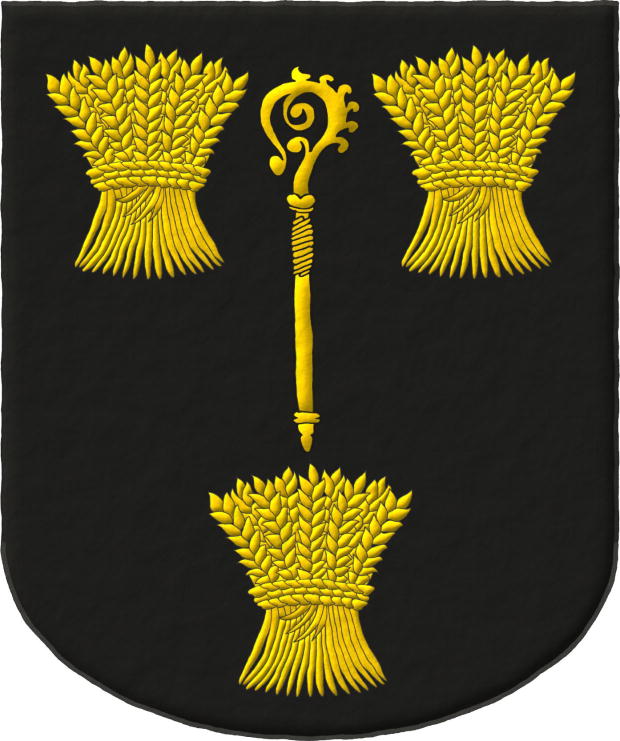
Daniel King, «The Vale-Royal of England or, The County Palatine of Chester Illustrated, wherein is Contained a Geographical and Historical Description of that Famous County, with all its Hundreds and Seats of the Nobility, Gentry and Freeholders», edited and published by Daniel King, engraver, book sponsored by Peter Venables, Baron of Kinderton, Chester, Cheshire County, 1656.
The book includes around 520 coats of arms of Cheshire, with black and white illustrations, where the metals and colors are indicated by a letter code.
The coat of arms that illustrates this bibliographic reference is one of those recorded in this book and corresponds to the coat of arms of Abadía de Delacres, with the difference that here the crozier faces the right side of the shield, unlike the one represented in this book, which, like other croziers in this book, faces the left side of the shield.
Bibliographical reference of century XVII.
Author: King, Daniel.
External links:


![Ver [Menestrier, C. F.; 1659] en referencias bibliográficas. Libro abierto, hojas de plata, filo de oro, guardas de gules, tapas de sable.](../css/Libro.Bibliografia.png)
Menestrier, C. F.; 1659
Claude-François Menestrier, member of the Society of Jesus, «Le veritable art du blason et la pratique des Armoiries depuis leur Institution», «Auec Privilege du Roy»~avec le privilège du roi, 10 pages of introduction, 415 pages of content, 14 pages of indexes and 339 pages in total, Chez Benoît Coral, ruë Merciere à la Victoire, Lyon, 1659.
Bibliographical reference of century XVII.
Classification: In black and white and French language.
Author: Menestrier, Claude-François.
The following article cites this bibliographic reference:
External resource:


![Ver [Mogrovejo de la Cerda, J.; 1636] en referencias bibliográficas. Libro abierto, hojas de plata, filo de oro, guardas de gules, tapas de sable.](../css/Libro.Bibliografia.png)
Mogrovejo de la Cerda, J.; 1636
Juan Mogrovejo de la Cerda, «Árbol de los Veras compuesto por Alonso López de Haro, Criado de Su Majestad y Ministro de su Real Consejo de las Órdenes y Cronista de los Reinos de Castilla y León», bound in original parchment, Milan, 1636.
Contents
The book contains a total of 66 main genealogical trees, each with an average of 28 nodes/persons, totaling over 1700 nodes. Additionally, it includes 41 lines of descent with approximately 1150 individuals. The content is composed of:
- Title page with the coat of arms of the Veras.
- Errata and additions.
- Dedication.
- Warnings and introduction by Juan Mogrovejo de la Cerda, folios 1 to 4.
- Tree of the Veras, folios 6 to 66, with 61 genealogical trees.
- Eulogies of five Christian princes known for their virtue and valor, with trees of their descendants up to the Count of La Roca, folios 67 to 72.
- Linear trees of descent from Don Fernando Carlos Antonio de Vera, Doña María Antonia de Vera y Tovar, and Doña Catalina de Vera, folios 73 to 114, with 41 trees.
- Limitations of the work on folio 115.
- Indexes with handwritten corrections, folios 116 to 122.
- Additions to the edition, including a genealogical tree of Don Luis Francisco de la Cerda Sandobal y Rojas, Marqués de Alcalá.
- Additional handwritten documents attached but not bound.
In the previous image, The canting arms of Juan Antonio de Vera y Zúñiga, Count of La Roca, in this book about his genealogy, are canting because «vair~veros~Vera».
The motto in the beak of his sable eagle is «Veritas Vincit», although some authors claim that not all his trees honor this motto [Vera-Ortiz, J.A.; 2009].
The colored version of the coat of arms in this image was painted by me. Blazon: Vair ancient, a bordure gules charged with eight saltires couped Or.
Bibliographical reference of century XVII.
Classification: De bibliotheca, In black and white and Castilian language.
The author is Mogrovejo de la Cerda, Juan.
Here are the articles quoting this reference:
External link:
Internal resources: Physical book..

![Ver [Petra Sancta, S.; 1634] en referencias bibliográficas. Libro abierto, hojas de plata, filo de oro, guardas de gules, tapas de sable.](../css/Libro.Bibliografia.png)
Petra Sancta, S.; 1634
Silvester Petra Sancta, «De symbolis heroicis», a work consisting of 9 books, published by Antuerpiae, Ex officina Plantiniana Balthasaris Moreti, 480 pages with an additional 35 unnumbered pages, measuring 21 centimeters, Liège, 1634.
Description
The title page features an engraved pictorial border, signed by Peter Paul Rubens as the painter and Cornelis Galle as the engraver. The preface is signed by Silvester Petra Sancta, a member of the Society of Jesus, dated March 1634, specifically noted as «Leodij Kal. Mart. M.DC.XXXIV», indicating that the preface was signed in Liège on March 1, 1634.
The book includes the section titled «Elogium gentis Carafaeae ac stemma procerum eius» on pages XVII-LXXX, covering topics related to the Carafa family, including 7 genealogical trees with the family's coat of arms, «Gules, three bars Argent» repeated with or without cadency marks.
This work is notable for its engravings and symbolic content, including mottos and figures. It consists of nine books, with page 479 incorrectly numbered as 749, followed by page 780, and then 5 indexes that assist in finding specific symbols, such as the symbolism of the swan on page 16.
Petra Sancta's hatching code
in the engraving on page XVI is where Silvester Petra Sancta's hatching code is best appreciated, which is the most widely used in heraldry today, with the color Gules of the field represented by vertical lines and the metal Argent of the three bars in white.
Bibliographical reference of century XVII.
Classification: Symbolism, In black and white and Latin language.
Author: Petra Sancta, Silvester.
External links:
Internal resources: PietrasantaS1634.SymbolisHeroicis.00.pdf version 00, PDF format and PietrasantaS1634.SymbolisHeroicis.01.pdf version 01, PDF format.


![Ver [Rio, M. del; 1608] en referencias bibliográficas. Libro abierto, hojas de plata, filo de oro, guardas de gules, tapas de sable.](../css/Libro.Bibliografia.png)
Rio, M. del; 1608
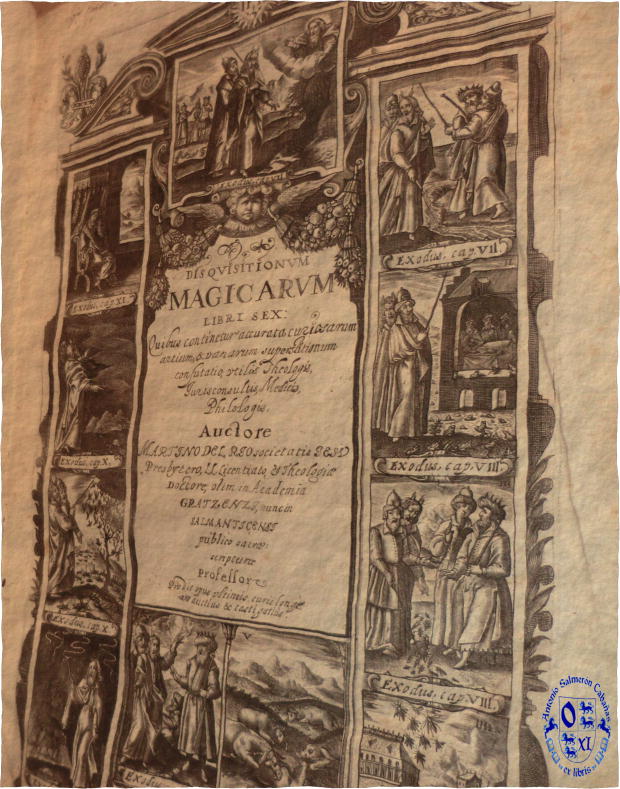
Martino Antoine del Rio, Societis Jesu, «Disquisitionum Magicarum Libri Sex: Quibus continetur accurata curiosarum artium et vanarum superstitionum confutatio, utilis Theologis, Jurisconsultis, Medicis, Philologis», Lugduni: apud Horatium Cardon, 1608.
There are other editions of this book, for example, the edition by Henning with 1,070 pages, from the year 1617.
The collage of images that accompanies this article corresponds to the inner cover of the 1608 edition of this book, that has been photographed by me, you can see my ex libris on the bottom of the of photography.
Bibliographical reference of century XVII.
Author: Rio, Martino del.
External link:


![Ver [Salazar y Mendoza, M. de; 1640] en referencias bibliográficas. Libro abierto, hojas de plata, filo de oro, guardas de gules, tapas de sable.](../css/Libro.Bibliografia.png)
Salazar y Mendoza, M. de; 1640
Miguel de Salazar y Mendoza, chronicler and chaplain of honor to Philip IV, «Formulario de armas», copied by Manuel Antonio Brochero in 1730, manuscript in the National Library of Spain, 11 volumes, volume 1 with 876 pages, call number MSS/11442, volume 2 with 378 pages, call number MSS/11443, volume 3 with 455 pages, call number MSS/11444, volume 4 with 392 pages, call number MSS/11445, volume 5 with 543 pages, call number MSS/11446, volume 6 with 455 pages, call number MSS/11447, volume 7 with 484 pages, call number MSS/11448, volume 8 with 309 pages, call number MSS/11449, volume 9 with 325 pages, call number MSS/11450, volume 10 with 302 pages, call number MSS/11451, volume 11 with 467 pages, call number MSS/11452, totaling approximately 5986 pages, 31 x 21 centimeters, circa 1640.
Dates of the original and copies
In Una Modesta Aportación Española, Juan Cartaya Baños writes that the original «Formulario de Armería» by Miguel de Salazar y Mendoza can be dated to around 1640, and that is the year I use to catalog it. He mentions that there is a 1739 copy that belonged to the King of Arms Zazo y Rosillo. In the National Library of Spain, there are three copies: this copy made by Manuel Antonio Brochero, titled «Formulario de Armería», in 11 volumes, dated by the BNE to the year 1730; another smaller copy made by Tomás Francisco Monleón y Ramiro, titled «Nobiliario o Formulario de Armería», with 980 pages, dated by the BNE to the year 1739; and another even smaller copy, titled «Formulario de Armería», with 404 pages, dated by the BNE to the 18th century.
Indexes and searches
There are indexes in all the volumes, these indexes are alphabetically ordered by the initial letter of the lineage name, but within each letter, the lineages are not strictly ordered, that is, they attempt to follow the order but there are some discrepancies, so you have to go through the entire letter to find the sought lineage. Next to the lineage name on the right, a number appears to locate it within that volume. Therefore, to ensure a thorough search, you need to review the indexes of all 11 volumes. For example, the Salazar lineage can be found in volume 1, in volume 2, in volume 4, etc. This mechanism, though somewhat challenging, allows for searches.
In the 2 images above, which are at the beginning of this section, you can see an example of a search, first, a page from the index of volume 3, dedicated to the letter S, where at the beginning of its second column, you can see the name of the Salmerón lineage, with the number 313 to its right. In the second image, you can see, from volume 3, the page with the number 313 at the top left, with the coat of arms of the Salmerón lineage described but not painted, which is similar to the one that appears in [Salazar y Mendoza, M. de; 1654; volume 5, page 196].
Coat of arms drawings
This armorial contains in volume 1, after the index, an introduction to the organization of coats of arms in quarters, spanning 12 pages and 7 black and white drawings.
Among the lineage descriptions, blank spaces are left, seemingly intended for drawing the coat of arms, many of these spaces are only outlined with the outer edge of a shield ending in a semicircular arch. The most complete coats of arms are those smaller ones that illustrate some lineages in black and white, mainly in the margins, as shown in the previous images. The spaces seem to be more systematically placed in the first volumes, with an average of 2 spaces per page, than in the later volumes.
Bibliographical reference of century XVII.
Classification: Manuscript, Armorial roll, Castilian language and In black and white.
Author: Salazar y Mendoza, Miguel de.
The following article cites this bibliographic reference:
External resources:
- National Library of Spain, Formulario de Armeria, 11 volumes, copy from 1730.
- National Library of Spain, Nobiliario o Formulario de Armeria, 980 pages, copy from 1739.
- National Library of Spain, Formulario de Armeria, 404 pages, copy from the 18th century.
Internal resources: SalazarMendozaM1640.Tomo.01.pdf volume 1 in PDF format, SalazarMendozaM1640.Tomo.02.pdf volume 2 in PDF format, SalazarMendozaM1640.Tomo.03.pdf volume 3 in PDF format, SalazarMendozaM1640.Tomo.04.pdf volume 4 in PDF format, SalazarMendozaM1640.Tomo.05.pdf volume 5 in PDF format, SalazarMendozaM1640.Tomo.06.pdf volume 6 in PDF format, SalazarMendozaM1640.Tomo.07.pdf volume 7 in PDF format, SalazarMendozaM1640.Tomo.08.pdf volume 8 in PDF format, SalazarMendozaM1640.Tomo.09.pdf volume 9 in PDF format, SalazarMendozaM1640.Tomo.10.pdf volume 10 in PDF format and SalazarMendozaM1640.Tomo.11.pdf volume 11 in PDF format.


![Ver [Salazar y Mendoza, M. de; 1654] en referencias bibliográficas. Libro abierto, hojas de plata, filo de oro, guardas de gules, tapas de sable.](../css/Libro.Bibliografia.png)
Salazar y Mendoza, M. de; 1654
Miguel de Salazar y Mendoza, chronicler and chaplain of honor to Philip IV, «Nobiliario de armas», with contributions from Lázaro Díez del Valle and others, manuscript in the National Library of Spain, 7 volumes, volume 1 with 1084 pages, call number MSS/12599, volume 2 with 926 pages, call number MSS/12600, volume 3 with 762 pages, call number MSS/12601, volume 4 with 614 pages, call number MSS/12602, volume 5 with 784 pages, call number MSS/12603, volume 6 with 1106 pages, call number MSS/12604, and volume 7 with 998 pages, call number MSS/12605, total approximately 6274 pages, 22 x 16 centimeters, by various authors with handwriting from different hands, 1654.
Dates and years
In volume 1, page 66, the year 1498 appears first, there are many years written on many pages, often related to events or positions held by the bearers of the described coats of arms. These are years from the 14th century onward. In the different volumes, there are also, though much less frequently, some dates with day, month, and year.
It is notable that, on that same page 66 of volume 1, on the last written line on the right, there appears what seems to be a signature, followed by the preposition «a» which is used in a formal sense to indicate the date on which a document is drafted or signed, and a specific date. It can be seen in the first image at the beginning of this section where « = Silva y Salazar. a 27 de abril de 1654 = » is highlighted in larger and darker font. However, only the second surname in «Silva y Salazar» matches that of the author «Miguel de Salazar y Mendoza», so it would be the signature of a different person or possibly a relative who worked for the author.
As I have mentioned, throughout this volume and the entire armorial, there are other years, generally earlier and some later than 1654. For example, in the 17th century, and specifically in this volume 1, on page 222, midway down on the right, the years 1697 and 1698 appear; on page 334, at the bottom right, I believe the year 1644 can be seen; on page 343, at the bottom right, the year 1638 appears.
To establish a reference year, I set it as 1654, only to have a temporal reference, even though this date appears signed by someone other than the author, on a note of paper smaller in size than the rest of the pages, this note talks about Ariño and is inserted just before the page dedicated to the coat of arms of the Ariño lineage. In any case, as can be observed and given the large number of pages, its writing must have extended over decades, and by several hands and authors, hence the appearance of later annotations such as 1697 and 1698.
The National Library of Spain dates it between 1601 and 1800, which is a very broad range of years.
Miguel de Salazar y Mendoza, was a chronicler and chaplain of honor to Philip IV who reigned from 1621 to 1665, he was the author of the «Formulario de Armeria» which some date to circa 1640, and of which there is a copy from 1739 that belonged to the King of Arms Zazo y Rosillo, also in the National Library of Spain.
Indexes and searches
There is a deteriorated index of all volumes at the beginning of volume 1, this index is alphabetically ordered by the initial letter of the lineage, but within each letter, the lineages are not strictly ordered, so one must read through the entire letter to find the sought lineage. Within each letter, there is an organization by volumes from 1 to 7, next to the name of the lineage on the right appears a number, and with that volume and number, the written coat of arms can be located. This mechanism, with some difficulty, allows for searches.
For example, in the 2 previous images, which are at the beginning of this section, you can see, first, a page from the index which is one of the pages dedicated to the letter S, in its section dedicated to volume 5, at the end of the 3rd column, you can see the name of the Salmerón lineage, with the number 196 to its right. In the second image, you can see, from volume 5, the page with the number 196 at the top right, with the coat of arms of the Salmerón lineage described, but not painted, and is similar to the description in [Salazar y Mendoza, M. de; 1640; volume 3, page 313].
Drawings of coats of arms
This armorial contains, in the first 43% of volume 1, coats of arms with a crest, helmet, mantling, and plume, in the final 57% of volume 1 and in the rest of the volumes from 2 to 7, only the coats of arms without a crest.
The drawn coats of arms are always finished with a rounded arch. The coats of arms without a crest are always in a vertical position. The coats of arms with a crest are tilted toward the dexter (heraldic right), which is the left from the observer’s point of view, and both the coat of arms and the helmet, the mantling, and the plume, these arms with its crest are pre-printed, for this, 2 different plates were used, which can be distinguished because one has a plume of 4 feathers and the other has a plume of 5 feathers, as can be seen in the 2 first images before this section.
The external shape of the arms without a crest and the interior of all the coat of arms arms in this armorial, are drawn in pen. As illustrated in the third image before this section: most of the coats of arms drawings are blank; some are only sketched; others have incomplete quarters; and some are more advanced; but none have tinctures. Only the tree in the Aznar lineage coat of arms in volume 1, page 66, is painted in vert (green), so I categorize this armorial as created in black and white. At the beginning of volume 1, it is noteworthy that among the initiated arms, there frequently appears a tree as the main charge.
Bibliographical reference of century XVII.
Classification: Manuscript, Armorial roll, Castilian language and In black and white.
The author is Salazar y Mendoza, Miguel de.
Bibliographical reference mentioned in the following article:
External resource:
Internal resources: 7 volumes in PDF format. SalazarMendozaM1654.Tomo.1.pdf tomo 1 in PDF format, SalazarMendozaM1654.Tomo.2.pdf tomo 2 in PDF format, SalazarMendozaM1654.Tomo.3.pdf tomo 3 in PDF format, SalazarMendozaM1654.Tomo.4.pdf tomo 4 in PDF format, SalazarMendozaM1654.Tomo.5.pdf tomo 5 in PDF format, SalazarMendozaM1654.Tomo.6.pdf tomo 6 in PDF format and SalazarMendozaM1654.Tomo.7.pdf tomo 7 in PDF format.


![Ver [Shakespeare, W.; 1608] en referencias bibliográficas. Libro abierto, hojas de plata, filo de oro, guardas de gules, tapas de sable.](../css/Libro.Bibliografia.png)
Shakespeare, W.; 1608
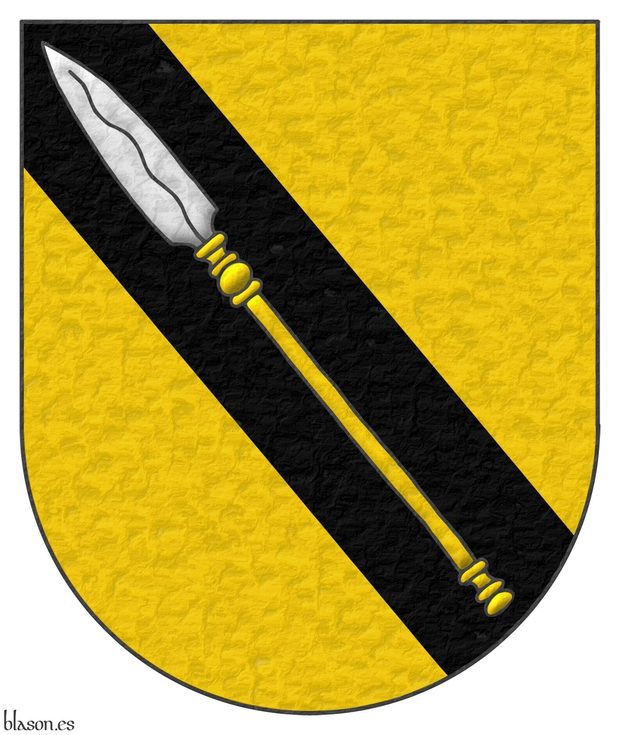
William Shakespeare, «Coriolanus», Tragedy in 5 acts and 29 scenes, written in verse, dated to either 1608 or 1609, depending on the sources.
It is one of the last works written by William Shakespeare, a tragedy based on the life of Caius Marcius Coriolanus, a legendary Roman general from the 5th century B.C. Some authors consider General Coriolanus to be a historical figure, while others do not.
Initially known only as Caius Marcius, during the war against the Volsci he becomes a hero by entering the city of Corioli with a few soldiers, and from then on, he is called Caius Marcius Coriolanus.
Act 3, Scene 2, Volumnia, mother of Coriolanus
I prithee now, my son,
Go to them, with this bonnet in thy hand;
And thus far having stretch'd it (here be with them)
Thy knee bussing the stones (for in such business
Action is eloquence, and the eyes of the ignorant
More learned than the ears) waving thy head,
Which often, thus, correcting thy stout heart,
Now humble as the ripest mulberry
That will not hold the handling: or say to them,
Thou art their soldier, and being bred in broils
Hast not the soft way which, thou dost confess,
Were fit for thee to use as they to claim,
In asking their good loves, but thou wilt frame
Thyself, forsooth, hereafter theirs, so far
As thou hast power and person.
Bibliographical reference of century XVII.
Author: Shakespeare, William.
External resource:


![Ver [Takamiya; 1620] en referencias bibliográficas. Libro abierto, hojas de plata, filo de oro, guardas de gules, tapas de sable.](../css/Libro.Bibliografia.png)
Takamiya; 1620
Anonymous, «Heraldic manuscript of the English kings and peers», Beinecke Rare Book and Manuscript Library, call number Takamiya MS 13, 236 pages, actually 235 due to a pagination error, manuscript on paper in English secretary hand, circa 1620.
Contents
Created circa 1620, this manuscript presents a genealogy of the rulers of England from Brutus and Julius Caesar to James I, including short biographies and more than 600 emblazoned coats of arms in full color. The manuscript spans 236, actually 235 pages, with a pagination error skipping page 182.
Binding
The manuscript is bound in nineteenth-century full polished calf by Clarke & Bedford, with a spine title «Arms of the Nobility of England. MS. 1042-1619». It includes four modern binder's blanks at the front and thirteen at the end.
Provenance
The manuscript originates from England and was part of the Toshiyuki Takamiya collection until 2013. It is classified as a Renaissance manuscript from the 17th century and is a significant resource for the study of English heraldry, genealogy, and nobility.
Bibliographical reference of century XVII.
Classification: Armorial roll, Manuscript, English language and In color.
The author is unknown.
External resource:
Internal resources: Takamiya1620.pdf Yale University Library Digital Collections, PDF format.


![Ver [Tejero de Rojas y Sandoval, J. F.; XVII] en referencias bibliográficas. Libro abierto, hojas de plata, filo de oro, guardas de gules, tapas de sable.](../css/Libro.Bibliografia.png)
Tejero de Rojas y Sandoval, J. F.; XVII
Juan Francisco Tejero de Rojas y Sandoval, «Linajes de Aragón, Castilla, León, Galicia, Cataluña, Navarra y Vizcaya», 198 hand-numbered pages, each 2, in Arabic numerals, with numerous blank pages not numbered at the beginning and end, hand index on the back of the last page before the back cover, 22 x 17 centimeters, illustrations in the pages 26-29, in the National Library of Spain, signatures Mss/12617, it is estimated from the XVII century.
Unfinished
Although the last page 198 is signed on the back, the book seems unfinished because at the end of the last page there is a last line with a few loose words «Duke of...» which are a sign that it continues on the next page, but the next page is blank.
Bibliographical reference of century XVII.
Classification: Manuscript, In black and white and Castilian language.
The author is Tejero de Rojas y Sandoval, Juan Francisco.
External links:
- Detail of this manuscript in the National Library of Spain.
- Bibliographic record of the National Library of Spain.
- Scanned manuscript in the National Library of Spain.
Internal resources: TejeroRojasSandovalJFXVII.Pagina.11.Linajes.pdf.
Credits: This book belongs to the Biblioteca Nacional de España. License Creative Commons CC-BY. You may share, transform and create from images in the public domain that are accessible in the Hispanic Digital Library.


![Ver [Tewkesbury; Century XVII] en referencias bibliográficas. Libro abierto, hojas de plata, filo de oro, guardas de gules, tapas de sable.](../css/Libro.Bibliografia.png)
Tewkesbury; Century XVII
Anonymous, «Founder's and benefactors' book of Tewkesbury abbey», Bodleian Libraries, University of Oxford, call number MS. Top. Glouc. d. 2, recorded in the Catalogue of Western Medieval Manuscripts in Oxford Libraries, manuscript, illustrated, 46 leaves, 245 x 175 millimeters, except fols. 12, 16, and 38, which are smaller, Tewkesbury, beginning of the 16th century.
Origin, historical context, and contents
It is is a medieval manuscript originating from Tewkesbury Abbey at the beginning of the 16th century. This Latin manuscript provides records and depictions of the abbey's founders and benefactors, such as: William Fitzcount, 2nd Earl of Gloucester, died 1183; Oddo and Doddo, Dukes of Mercia; Hugh, great Duke of Mercia, lord of the manor of Tewkesbury, buried at Tewkesbury in 812; Robert Fitzhamon, lord of Creully, Calvados in Normandy, died 1107, and his wife, Sybil, patrons of Tewkesbury Abbey’s reconstruction; Edward Despenser, died 1375; Thomas Despenser, Earl of Gloucester, died 1400; and Isabel Despenser, 1400-1439.
Illustrations and manuscript details
The manuscript is noted for its illustrations, which are believed to have been created by John of Evesham, a monk at Tewkesbury. The illustrations are thought to be copied from painted statues, approximately 70 cm high, which once decorated the abbey church. The manuscript comprises 46 leaves, with most pages measuring 245 x 175 millimeters, though folios 12, 16, and 38 are smaller in size.
In the image, folio 25v depicts Thomas Despenser, Earl of Gloucester, in armor, wearing a red bonnet with a badge, and a mantle with epaulettes over a heraldic surcoat. He holds a sheathed sword and is surrounded by six coats of arms and the badge of the Garter with the flag of Saint George; and folio 26r features a text page with ten coat of arms.
Bibliographical reference of century XVII.
Classification: Manuscript, Armorial roll, Latin language and In color.
The author is unknown.
The following article cites this bibliographic reference:
External resource:
Internal resources: 25 images in JPEG format.
-
Language
-
Categories of heraldry
-
Divisions of the field
- Without divisions
- Party per pale
- Party per fess
- Party per bend
- Party per bend sinister
- Tierce
- Tierce sinister
- Tierced per pale
- Tierced per fess
- Tierced per bend
- Tierced pallwise inverted
- Quarterly
- Quarterly per saltire
- Gyronny
- Party per fess, the chief per pale
- Party per pale, the sinister per fess
- Party per fess, the base per pale
- Party per pale, the dexter per fess
- Chapé
- Chaussé
- Embrassé
- Contre-embrassé
- Party per chevron
- Enté
- Enté en point
- Flanched
-
Metals
-
Colours
-
Furs
-
Other tinctures
-
Ordinaries and sub-ordinaries
-
Diminutives of the ordinaries
-
Geometric charges
-
Composite ordinaries
-
Inanimate charges from Nature
Atom, Crescent, Diamond, Emerald, Estoile, Increscent, Lightning flash, Moon, Mount, Mullet, Mullet of four points, Orbital, Plough of Ursa Major, Rainbow, Ray of the sun, River, Sea, Snowflake, Sun, Sun in splendour, Sun of May, Trimount, Water and Wave.
-
Vegetal charges from Nature
Acorn, Apple, Apple tree, Ash, Bluebonnet, Camellia, Chrysanthemum, Cinquefoil, Cornflower, Dogwood flower, Double rose, Elm, Fleur de lis, Flower, Gourd, Holm oak, Hop cone, Kapok tree, Laurel, Lily, Linden, Lotus flower, Madonna lily, Mexican cedar tree, Oak, Olive tree, Palm tree, Plantain plant, Pomegranate, Poplar leaf, Rose, Shamrock, Sunflower, Thistle, Tree, Tulip, Vine and Wheat.
-
Animal charges from Nature
Badger, Bald eagle, Barbel, Barn owl, Bear, Beaver, Beetle, Bighorn sheep, Blackbird, Boar, Brach hound, Bull, Doe, Dog, Dolphin, Dove, Eagle, Elephant, Falcon, Female figure, Fish, Flame, Fly, Fox, Frog, Goat, Goldfinch, Goose, Heron, Horse, Hummingbird, Jaguar, Lark, Leopard, Lion, Lion passant, Lion rampant guardant, Lioness, Lynx, Male figure, Martlet, Merino ram, Owl, Panther, Parrot, Peacock, Pelican, Pelican in her piety, Puffin, Quetzal, Raven, Roe deer, Rooster, Savage, Seagull, Serpent, She-wolf, Stag, Starling, Talbot, Tyger, Vulture, Warren hound and Wolf.
-
Parts of natural charges
Arm, Beak, Branch, Caboshed, Chest, Claw, Covert, Dorsal fin, Eagle claw, Ermine spot, Escallop, Feather, Foot (palmiped), Foreleg, Forepaw, Hand, Head, Heart, Hoof, Leaf, Neck, Ostrich feather, Palm frond, Paw, Roe deers' attires, Shoulder, Sprig, Stags' attires, Stem, Swallow-tail, Tail, Tail addorsed, Tail fin, Talon, Tooth, Trunk, Trunk (elephant), Two hands clasped, Two wings in vol, Udder, Wheat spike, Wing and Wrist.
-
Artificial charges
Ace of spades, Anchor, Anvil, Arch, Arm vambraced, Armillary sphere, Arrow, Axe, Bell, Bell tower, Beret, Bonfire, Book, Bookmark, Bow, Branding iron, Bridge, Broken, Buckle, Cannon, Cannon dismounted, Cannon port, Canopy roof, Carbuncle, Castle, Celtic Trinity knot, Chain, Chess rooks, Church, Clarion, Clay pot, Closed book, Club, Column, Comb, Compass rose, Conductor's baton, Cord, Covered cup, Crozier, Crucible, Cuffed, Cup, Cyclamor, Dagger, Double vajra, Drum, Ecclesiastical cap, Fanon, Federschwert, Fleam, Four crescents joined millsailwise, Galician granary, Garb, Gauntlet, Geometric solid, Grenade, Halberd, Hammer, Harp, Host, Hourglass, Key, Key ward, Knight, Knot, Lantern, Letter, Line, Loincloth, Menorah, Millrind, Millstone, Millwheel, Monstrance, Mortar, Mullet of six points pierced, Nail, Non-classic artifact, Norman ship, Number, Oar, Oil lamp, Open book, Page, Pair of scales, Parchment, Pestle, Piano, Pilgrim's staff, Plough share, Polish winged hussar, Port, Portcullis, Potent, Quill, Ribbon, Rosette of acanthus leaves, Sabre, Sackbut, Sail, Scroll, Scythe, Sheaf of tobacco, Ship, Skirt, Spear, Spear's head, Stairway, Star of David, Step, Sword, Symbol, Tetrahedron, Torch, Tower, Trident, Trumpet, Turret, Two-handed sword, Wagon-wheel, Water-bouget, Wheel, Winnowing fan and With a turret.
-
Immaterial charges
Angel, Archangel, Basilisk, Dragon, Dragon's head, Garuda, Golden fleece, Griffin, Heart enflamed, Justice, Mermaid, Our Lady of Mercy, Ouroboros, Paschal lamb, Pegasus, Phoenix, Sacred Heart of Jesus, Saint George, Sea-griffin, Trinity, Triton, Unicorn, Winged hand and Wyvern.
-
External elements
-
Heraldic creations
-
References
-
Formats
-
Keywords on this page
Between, Armorial roll, Bend, Bibliography, Bordure, Crozier, Charged, Cheshire County, Party per fess, De bibliotheca, In black and white, In color, Photographic, Garb, Genealogy, Gules, Spear, Castilian language, French language, English language, Latin language, Manuscript, Eight, Ordered, Or, Argent, Without divisions, Bendwise, Kingdom of England, Sable, Century XVII, Symbolism, Saltire, Wheat, One and Vair ancient.

